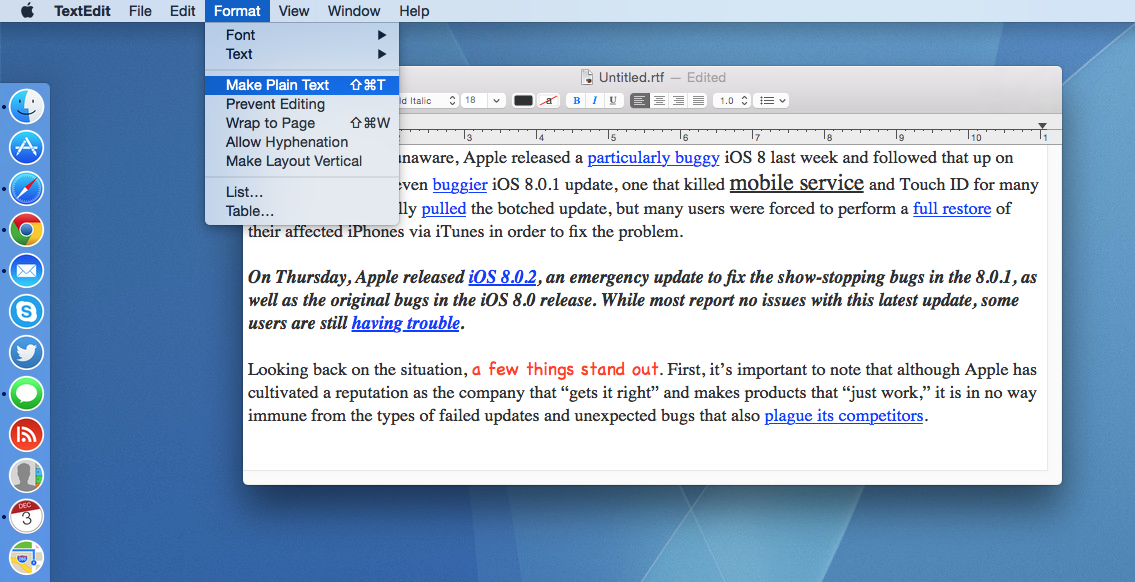Even if an operating system claims to be able to read UDF 1.50, it still may only support the plain build and not necessarily either the VAT or Spared UDF builds. Mac OS X 10.4.5 claims to support Revision 1.50 (see man mountudf ), yet it can only mount disks of the plain build properly and provides no virtualization support at all. Mac os x black background plain apple wallpaper. Fresh HD wallpapers for your desktop. Double-click the font in the Finder, then click Install Font in the font preview window that opens. After your Mac validates the font and opens the Font Book app, the font is installed and available for use.
Linc Davis is correct. The kernel extension (kext) that is needed is either a 'tun' or a 'tap' kext, depending on which type of VPN you are creating (it is something specified in the OpenVPN configuration file, and must be the same on the server and the client).
The kexts used by Tunnelblick [1] are from the tuntaposx project [2]. Tunnelblick includes several versions of each of the tun and tap kexts (one for OS X 10.4 and 10.5, one for 10.6 - 10.8, and one for 10.9) and loads/unloads the appropriate version dynamically as the VPN is created/destroyed.
Tunnelblick also includes binaries of two versions of OpenVPN with the latest version of the OpenSSL [3] library imbedded in each. If you use a version of OpenVPN that does not imbed OpenSSL, OpenVPN will use the command-line version of OpenSSL included in your version of OS X. That is almost always an old version and will not include some high-key-length ciphers, which means they wiil be unavailable.
If you use Tunnelblick, that's all you need -- it contains everything you need. If you want to 'do it yourself', you'll need OpenVPN and either a tun or a tap kext (or both, depending on your configurations), and you may want a newer version of OpenVPN.
Viscosity [4] also includes the necessary kexts and I believe it also imbeds an OpenSSL library in its OpenVPN binary. Viscosity has a version for Windows, too.
https://mac-house-os-rain-eternity-torrent-high-tw.peatix.com.
1. https://tunnelblick.net https://mac-hxh-qinoto-resourcessoftware-os.peatix.com.
Reflexes mac os. 2. http://tuntaposx.sourceforge.net
3. https://www.openssl.org
4. http://www.sparklabs.com/viscosity
Mar 17, 2014 8:12 PM
Try to start up from macOS Recovery
If your Mac seems to be turned on but nothing appears on your display, determine whether you're using a Mac with Apple silicon, then follow the appropriate steps:

Apple silicon
- Press and hold the power button for about 10 seconds.
- You should see the startup options window, which includes a gear icon labeled Options. Select Options, then click Continue.
- If you never see the startup options window, release the power button, then press and hold it again for another 10 seconds. If the issue persists, please contact Apple Support.
Intel processor
- Press and hold the power button for about 10 seconds.
- Press and release the power button, then immediately press and hold Command (⌘)-R until you see an Apple logo or other image.
- If you still see a blank screen after about 20 seconds, contact Apple Support.
Use Disk Utility to repair your startup disk
Plain Mac Os Update
If your Mac successfully started up from macOS Recovery, you should see a utilities window that includes Disk Utility. Use Disk Utility to repair your startup disk.
If Disk Utility found no errors, reinstall macOS.
If Disk Utility found errors and repaired them, restart your Mac. If the issue returns after restarting, reinstall macOS.
Mac Os Catalina
If you still need help, please contact Apple Support.

